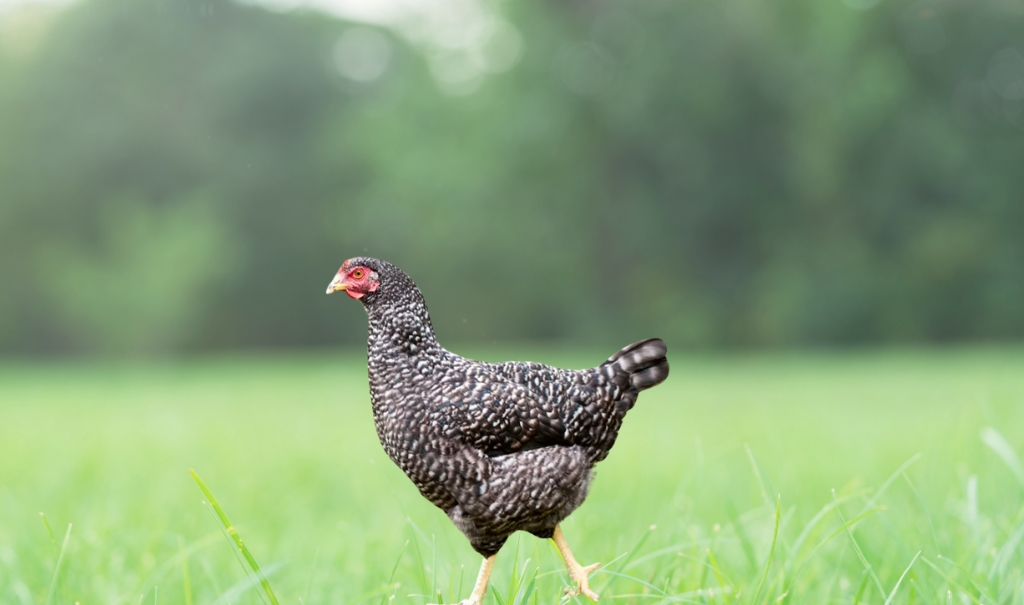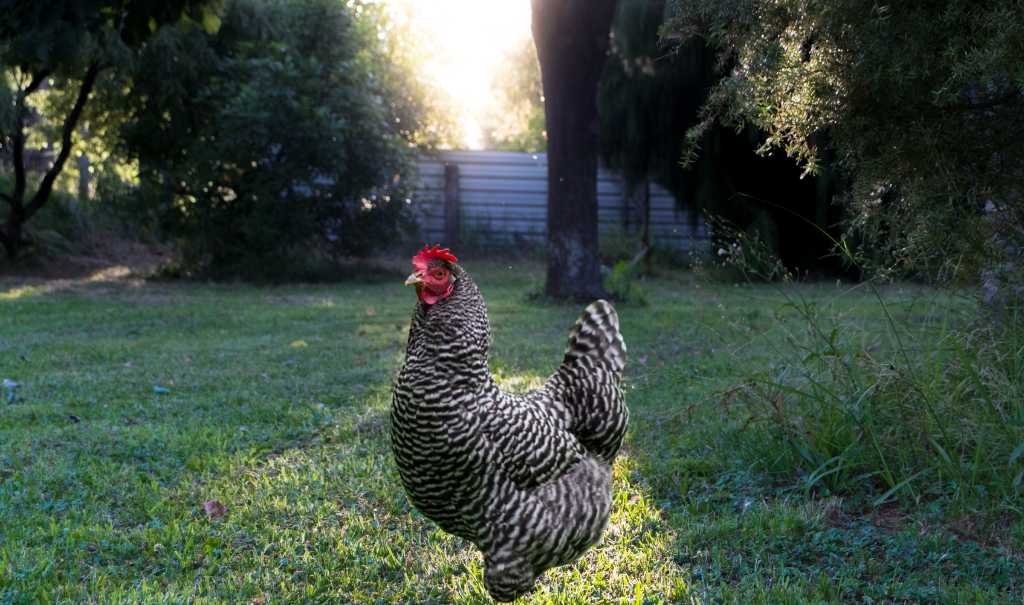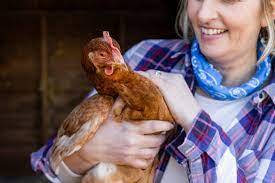Plymouth Rock chickens are a popular and useful breed that is known for being friendly and good at producing eggs and meat. But what makes them different from other chicken breeds? Now that we know more about Plymouth Rock chickens, we can see why they are so popular with chicken lovers.

Origin and History
In the middle of the 1800s, the Plymouth Rock chicken was first made in Massachusetts, USA. The first Plymouth Rocks were shown in 1849. They were created by mixing Dominiques, Dorkings, and other breeds. Breeders tried to make a bird that could do two things well: lay eggs and make good meat.
In 1865, the breed became more well-known, and the American Poultry Association recognized the Barred Plymouth Rock in 1874. The breed’s adaptability, toughness, and friendliness made it a popular choice for farms and backyards, and it still is.
Why It’s a Popular Breed?
Plymouth Rocks are known for being calm and easy to handle, which makes them a great choice for both new and experienced chicken keepers. Their ability to lay eggs very well and produce a lot of meat makes them a very popular breed for small farms and backyard coops.
Characteristics
Size and Weight
The Plymouth Rock is a medium- to large-sized bird. Hens weigh about 2.9 kg, and roosters can be as heavy as 3.4 kg. One reason they are desirable for meat output is their large size.
Plumage and Color Variations
The Barred Plymouth Rock is the most famous type. Its striking black and white striped feathers make it stand out. White, Buff, Silver Penciled, Partridge, Columbian, and Blue are some of the other color versions. Each type has a different design on its feathers, but they are all strong and useful.
Temperament and Behavior
People love Plymouth Rocks because they are friendly and easy to train. They are interested but not too hostile, which makes them great for families with kids. They are also very tough and can live in a wide range of temperatures, though they like to live in a safe and comfortable place.
Types of Plymouth Rock Chickens
Barred Plymouth Rock
The most well-known type is the Barred Plymouth Rock, which has black and white feathers with bars on them. This breed is both aesthetically pleasing and very effective in terms of egg and meat production.
White Plymouth Rock
With its pure white feathers, the White Plymouth Rock is a great choice for people who want a chicken that looks more traditional. It produces just as many eggs as the other type, and because it looks clean, it is often used to raise broilers.
Different Types
In addition to the Barred and White Plymouth Rocks, there are the Buff, Silver Penciled, Partridge, Columbian, and Blue types. While each one retains the breed’s main traits, it gives a group its own unique look.
Egg Production and Meat Quality
How many eggs does the Plymouth Rock lay?
Plymouth Rock chickens are great layers; they lay about 200 to 280 brown eggs a year. They start laying eggs when they are 20 to 24 weeks old, and they keep doing it for the rest of their lives. Most of the time, the eggs are medium to big and a beautiful light brown colour. The regularity of egg size and color makes them more appealing, especially to people who want to sell eggs.
What is the meat quality of Plymouth Rocks?
People also like Plymouth Rocks for their meat, not just their eggs. The meat is tasty, soft, and has a good texture, which is why it’s popular for roasting and other cooking tasks.
Caring for Plymouth Rock Chickens
Housing Requirements
It is, therefore, important to create good living conditions for Plymouth Rock chickens where their security is observed with good air circulation. This is because they enjoy the liberty of moving most of the time and searching for food hence a big run is preferred. It is recommended that the birds are provided with 4 square feet of floor space inside the house and 8-10 square feet in the yard/ run.
Food and Nutrition
Plymouth Rocks should also take a balanced diet so that it can be healthy and give out its best in productivity. The breed will remain healthy as long as they eat good food that has proteins and Performing veggies and grains occasionally as a treat.
Raising Plymouth Rock Chickens
How to Start a Flock?
Actually, getting a group of Plymouth Rock chickens off the ground is not very difficult. You can begin with chicks obtained from a breeder or a nursery that you’re confident with. For the first few weeks, they should be kept warm in a brooder and be well tended to.
Breeding and Hatching
This is especially important if you intend to have Plymouth Rocks because to start breeding it, you have to get birds that are strong and healthy. They are good layers and are also known to go brood; that is, they can sit on their eggs if they can get a hold of their chicks.

What are the health issues of Plymouth Rock Chickens?
Even though Plymouth Rocks are usually very hardy, they can get mites, lice, and respiratory problems, just like any other chicken. Keeping an eye on them and treating problems right away can help keep your flock healthy.
Are Plymouth Rock Chickens Hardy?
Yes, Plymouth Rock chickens are known for being tough. They: Do well in a range of temperatures and climates
- Easily fight off diseases
- Be able to handle cold winters and hot summers
- Are strong and live a long time (8–12 years)
- Your defence system should be strong.
- Are able to live either free-range or in a small space
Their hardiness makes them a popular choice for backyard flocks and small farms.
What are the benefits of Plymouth Rock Chickens?
Here are the benefits of Plymouth Rock Chickens:
- Excellent Egg Production: Each year, Plymouth Rocks lays 200 to 280 big brown eggs, which makes them a good choice for people who want to raise chickens for eggs.
- Hardy and resilient, they do well in a wide range of conditions, don’t get sick easily, and can handle high and low temperatures.
- Friendly and Docile: Plymouth Rocks are known for being friendly and gentle, which makes them great for families with kids.
- Dual-Purpose Breed: They’re suitable for egg and meat production, and roosters weigh 3.4 kg.
- Low Maintenance: Plymouth Rocks are simple to take care of; they don’t need much special attention and do well in small areas or free-range systems.
Overall, Plymouth Rock chickens are a breed that can do many things well and are reliable. They are also fun to have in your garden.
Final Thought
Finally, Plymouth Rock chickens are a friendly type that can do a lot of different things and are great for producing both eggs and meat. They are hardy, easy to care for, and have friendly personalities, which makes them popular with both new and experienced chicken keepers. They add value and charm to any backyard group.
FAQs
Are Plymouth Rock Chickens Good for Beginners?
Yes, Plymouth Rock chickens are excellent for beginners due to their friendly nature, hardiness, and ease of care.
How Long Do Plymouth Rock Chickens Live?
With proper care, Plymouth Rock chickens can live between 6 to 8 years, though some may live longer.
Do Plymouth Rock Chickens Need a Lot of Space?
While they enjoy having space to roam, Plymouth Rocks can adapt to smaller coops if they have enough room to move around comfortably.
Can Plymouth Rock Chickens Be Raised in Cold Climates?
Yes, they are quite hardy and can tolerate cold climates well, especially if they have a well-insulated coop.
What is the Difference Between Plymouth Rock and Barred Rock?
“Barred Rock” refers to the specific barred feather pattern variety of the Plymouth Rock breed. So, all Barred Rocks are Plymouth Rocks, but not all Plymouth Rocks are Barred Rocks.


